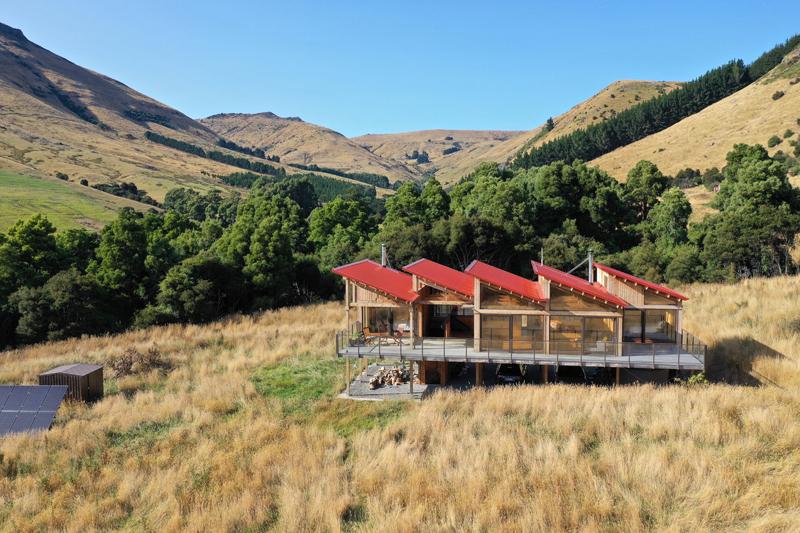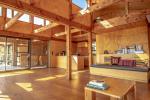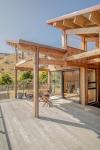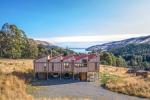Houhere House: Returning To The Wild Off The Grid

When the owners of Houhere bought a piece of land on Banks Peninsula six years ago, the intention was to return it to a natural setting and build a home that could transition from a weekender to a permanent residence.
They already had a cottage nearby so they left the land to ‘re-wild’ – the hillside grass paddocks changing back to tussock – while they considered what they might build on the Banks Peninsula site. Before selling the cottage, they dug up small, self-seeded natives from that garden and, over time, transferred them to the new 4ha site, which was once part of an old farm. Their home – Houhere – is named after the native lacebark and ribbonwood, species they have planted on the property along with other natives such as five-finger, ngaio and totara.
When they decided they wanted an architect-designed home, they approached Tim Nees, who they knew of through a mutual acquaintance, to ask him about the process.
The clients said, “In the meantime, we had a look at some of Tim’s work and really liked it. So we went from asking his advice to employing him.” They met with Tim on the land, which is nestled in a valley facing north with beautiful views over the local bay toward the distant Kaikoura Ranges.
There was already a building site consented that had the best views, the best outlook and was comparatively flat, with a hill behind it and a drop below it before the land flattens out again. Tim said, “The brief was for an informal and robust weekend retreat, to eventually become the clients’ retirement home.
“It was designed not only to be striking, but also to take advantage of water views and hillside vistas on each side, while letting in light and breezes. The living areas and extensive deck have been elevated above ground level, with cars, storage and service areas placed in the open ground floor area.” Tim said his clients had a budget in mind but were open-minded about the design although they wanted to live off-grid.
“They had pretty modest requirements – two bedrooms and a bathroom and a study space that could also be a guest bedroom.” He said that the saw tooth roof he designed looked “most appropriate” in the setting, the only problem being that it wasn’t ideal for the requisite solar panels.
“Part of the brief was an off-grid house but the roof forms that would have been good for having solar panels mounted on them didn’t suit the style of house that the clients wanted.”
The solution was to stick with the purity of the design and have solar panels frame-mounted on the ground.
Tim said the east-facing sawtooth roofline creates a series of clerestory windows that capture morning sun but shields the occupants from the heat of the afternoon sun.
“You also capture some beautiful sky views through those clerestory windows.”
The clients said, “Tim came up with the sawtooth design after we said we wanted something that made a statement yet also fitted into the landscape.”
The NZIA also thought the design made a statement, earning it a Canterbury Award this year. The judges said: “This house was built with retirement in mind. It references the rural vernacular of DOC huts, resulting in an architecture that is unpretentious, functional and uplifting. The house is a celebration of sustainable construction and living, and expresses its integrity through its crafted timber construction and as a sustainable insertion into a powerful rural setting.”
Tim’s design has the ground floor area being open apart from a storage shed and an enclosed entrance way for the stairs up to the home proper. This open area also accommodates cars, two water tanks and a woodpile.
Tim said, “I came up with the idea of raising the house above-ground mainly because of the rainfall runoff from the adjacent hillsides. There’s a fair bit of rainwater that comes through there from time to time. From the ground floor, it’s a logical extension to bring the post and beam construction up through to the next floor. The whole idea was to create a home with as low a carbon footprint as possible so it didn’t make sense to pour a concrete pad. There’s a tiny bit of concrete and a little bit of steel that has been used but essentially it’s a wooden house.”
When it came to the roof colour for the COLORSTEEL® Corrugate, Tim chose to make a statement with the bright ‘Pioneer Red’.
The clients loved it and their neighbours did, too, using the same roof colour on their home. Tim said ‘Pioneer Red’ was also a nod to the old local buildings, many of which feature that colour in various shades and states of repair.
The sawtooth roofline means internal trough gutters run the length of the house and collect rainwater for the two water tanks.
The clients said that although a relative, who is a retired engineer, was worried about flooding from internal gutters, that has never been an issue. “The guttering is really broad – more than a foot across – and deep as well, and the water flows into rain-catching boxes before going into the water tanks.
“There is bird proofing mesh over the top of the troughs and when you get hail or snow, it sits on the top of the mesh and melts into the channel.” The home is clad in vertically oriented larch weatherboards and has Purple Heart decking. Inside, a purposeful mix of non-treated timber features throughout the 135sqm home, including exposed beams of NZ Oregon and plywood linings. Some guests find that the interior reminds them of the pared back look of a DOC hut. “But that was what we wanted: no plaster, no paint – just wood and plywood.”
Tim said the ambience is “tramping hut chic”. “The whole focus for the owners is working on the property and re-wilding it – bringing the plants and insects back on the site – so they wanted a robust and rustic property that was suited to people tramping in and out of the house. They also have two big dogs.”
Self-sustaining and completely off the grid, the house also has bio-sewage treatment tanks and two woodburners, one with a wetback.
For the clients, going off-grid was a no-brainer as it was half the price to set up a solar system with panels, inverter and batteries, and back-up generator as it would have been to connect to the grid. They have never had to turn the generator on apart from giving it a run for maintenance. Having Tim on board throughout the build was a total game-changer – managing a process that might otherwise have been highly stressful, the clients said. He was able to point them towards tried and proven systems for setting up a sustainable home.
“He along with our builder, HQ Construction, was fabulous to work with,” they said. “Our home is an absolute dream to live in because it’s functional as well as being aesthetically pleasing.”



